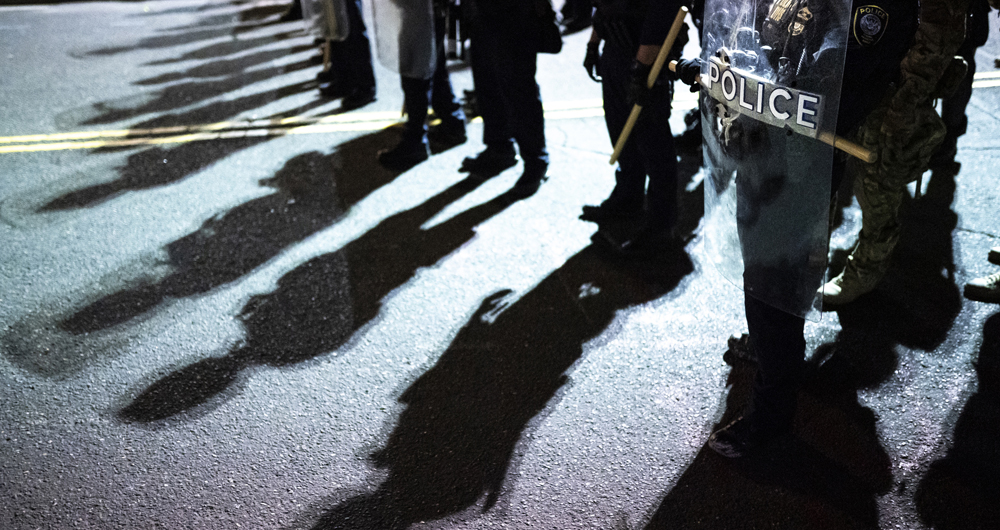IS THERE COMMOTION TO COME ABOUT (UN)CIVIL COMMOTION?
Insurers must think clearly about what constitutes “civil commotion” and what protection insureds can reasonably expect
By Joseph S. Harrington, CPCU
One does not have to believe that North America is on the brink of civil war to
recognize that there is profound frustration
at both ends of the political spectrum.
As this blog post is being written, federal, provincial, and local police forces in Canada are restoring commerce after spontaneous demonstrations by truck drivers protesting COVID-19 vaccine requirements.
For a time, the Canadian truckers’ action was supported, celebrated, and even funded by people on the right end of the political spectrum in the United States and elsewhere. That support was almost a mirror image of the support shown on the political left for demonstrations following the killing of George Floyd in 2020.
For insurers and their clients, these extended incidents of “civil unrest” shared troubling similarities.
First, there was physical damage to insured property and loss of income as a result of that damage, which is typically covered under commercial property insurance in both the U.S. and Canada. Losses extended far beyond that directly connected to physical damage, however.
In 2020, access to commercial districts of American cities was restricted or cut off entirely, even during generally peaceful protests. In early 2022, truckers used big vehicles to close off commerce in Canada’s capital city and threatened a major disruption of the North American auto industry by blocking bridge traffic between the U.S. and Canada.
Ominously, these disruptions were cheered by people at both ends of the political spectrum.
What is civil commotion?
If citizens make a habit of shutting down commerce by demonstrations, insurers may be forced to review their approach to “civil commotion.”
In the 19th century, fire insurance policies in North America tended to exclude coverage for fire losses arising from “riots or civil commotion,” a position based on the common law principle that a municipality was liable for damage to private property during a disturbance. To insure privately against such damage might allow a government to shirk its responsibility to maintain law and order.
That idea steadily changed over the 20th century. Riots and civil commotions, including those related to labor strikes, came to be regarded as tempests—that is, as spontaneous and fortuitous outbursts that could be insured, like weather tempests. Today, riots and civil commotion are commonly insured under commercial property policies in the U.S. and Canada.
It’s not easy to distinguish between a “disturbance,” a “riot,” or an “insurrection,” as we can attest from debate over the January 6, 2021, events at the U.S. Capitol. Riots are, however, officially declared as such by a public authority, making it possible to determine what losses occurred during the time and in the area indicated in a riot declaration.
“Civil commotion” carries no such official designation. Any coverage determinations regarding civil commotion rely on common understandings of the term, which is imprecise, at best. “Civil commotion” is not a defined term in property policies developed by the Insurance Services Office (ISO), the leading U.S. insurance advisory organization. The fact that ISO policies refer to the perils as “riot or civil commotion” (emphasis added) suggests a distinction between the two—that civil commotion is not dependent on the presence of a declared riot.
Open-ended exposure
It was noteworthy that Property Claims Services (PCS), a companion company of ISO in the Verisk Analytics organization, designated the 2020 unrest in the U.S. as the first multi-state riot-civil commotion catastrophe in the organization’s history. (Previously, individual riots were declared catastrophes.) The PCS designation demonstrated just how open-ended exposure to “riot or civil commotion” can be.
As for a common definition, the website Investopedia states that “civil commotion refers to a public gathering of a large number of people that results in property damage. It is generally the result of a revolt or riot by a large number of people that occurs in a public space.” (Emphases added.)
A narrow reading of “civil commotion” along this line would exclude income losses from any unrest or disturbances that did not involve any property damage. As a practical matter, however, almost any disturbance large enough to trigger an insurable income loss will involve some property damage, however small and incidental. As the second sentence of the Investopedia definition indicates, a revolt or riot by a large number of people is a common, but not essential, component of civil commotion.
“Civil commotion” is also not a defined term in standard Canadian property policies. In a glossary for the general public, the Insurance Institute of Canada and Insurance Bureau of Canada define civil commotion as: “Disturbance involving a large number of individuals. An uprising of people creating a prolonged disturbance.” There is no reference to property damage.
The glossary states that it is “for educational purposes only and should not be relied upon to form professional opinions on coverage issues.”
Political paralysis
Rightly or wrongly, people take to the streets when they believe they cannot achieve their public aspirations through formal channels. Protesters often find voices endorsing their action, even as other voices condemn them.
One does not have to believe that North America is on the brink of civil war to recognize that there is profound frustration at both ends of the political spectrum. Indeed, if there was an actual civil war, insurers would be off the hook for most of the resulting damage.
What insurers and their clients face instead is the prospect of periodic shutdowns of commerce by people exercising their right to express themselves at the expense of other peoples’ rights to do business. When the sentiments driving demonstrations are shared widely and deeply among the population, law enforcement is understandably reluctant to come down hard on violators.
As long as this goes on, insurers will have to think clearly about what constitutes “civil commotion,” and what protection their insureds can reasonably expect.
The author
Joseph S. Harrington, CPCU, is an independent business writer specializing in property and casualty insurance coverages and operations. For 21 years, Joe was the communications director for the American Association of Insurance Services (AAIS), a P-C advisory organization. Prior to that, Joe worked in journalism and as a reporter and editor in financial services.





